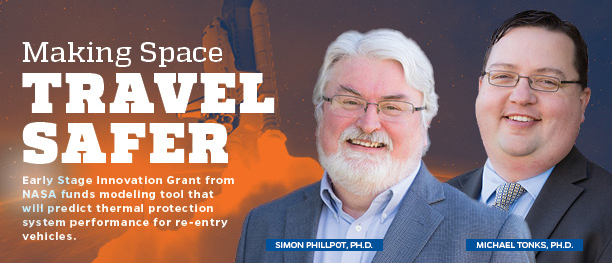We might all be familiar with scenes in movies and television programs where a spacecraft is entering Earth’s atmosphere and red glow forms as the space craft heats up. In reality, special heat resistant tiles are used to absorb this heat. However, if the reentry angle is too steep, these tiles get too hot and the spacecraft will burn up.
Reusable tiles, like those used on the space shuttles, require fairly shallow reentry angles. However, there is another kind of heat shield specifically designed to burn away on reentry, removing more of the heat and allowing steeper reentry angles. These materials, such as “PICA” (phenolic impregnated carbon ablator, a composite of a phenolic resin and carbon fibers), both increase safety and decrease costs. However, they can be difficult to design because conditions of reentry are difficult to duplicate in a laboratory.
This may soon change, though. UF Department of Materials Science Professors Michael Tonks, Ph.D., and Simon Phillpot, Ph.D. received a $500,000 Early Stage Innovation Grant through NASA to develop a modeling tool that will predict the performance of PICA heat shields, including how well they block the heat and the rate at which they burn off during reentry. This model will make it faster and easier to design safe heat shields by decreasing the number of difficult experiments that are needed and making it easier to optimize the structure of the material.
This research seeks to develop a model at the “mesoscale,” meaning at the scale you would see with a microscope. This small length scale will allow the model to represent the structure of the carbon fibers and the resin, so that structures that give better performance can be designed.
The model will predict the pyrolysis of the PICA (when the resin burns and becomes a char), and the ablation (the vaporization of the char and the fibers). The model will describe all the mechanisms that impact the PICA behavior with more detail than has ever been achieved, building on atomic-level simulations that will be carried out as part of the project.
The new mesoscale model will provide critical capability to simulate the heat shield behavior and optimize its structure to improve the performance. Thus, this project is a critical step to make space travel, something that the nation as well as private citizens alike are eager to explore, safer and more economical in the future.
